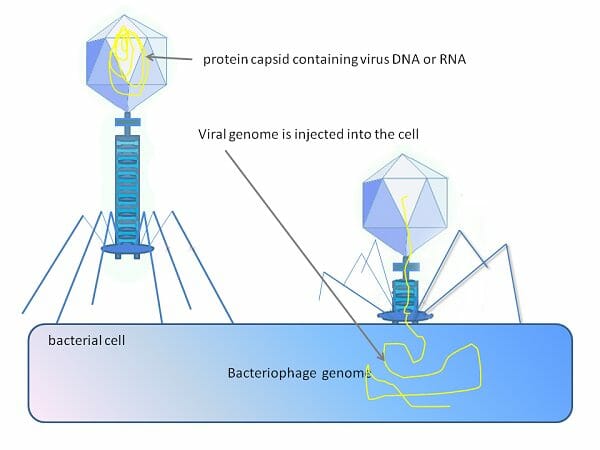Lysogenic Cycle Definition
The lysogenic cycle is a method by which a virus can replicate its DNA using a host cell. Typically, viruses can undergo two types of DNA replication: the lysogenic cycle or the lytic cycle. In the lysogenic cycle, the DNA is only replicated, not translated into proteins. In the lytic cycle, the DNA is multiplied many times and proteins are formed using processes stolen from the bacteria. While the lysogenic cycle can sometimes happen in eukaryotes, prokaryotes or bacteria are much better understood examples.
A bacteriophage, or bacteria virus, injects its DNA into the bacteria. The DNA is then replicated when the bacteria undergo cell division. Because all DNA is made of the same base molecules, and viral DNA is no exception, the same chemical reaction that replicates bacterial DNA can replicate viral DNA. Since these processes are already happening in the bacteria, the lysogenic cycle can be thought of as the virus hitching a ride on the efforts already being spent by the bacteria. Typically, the bacteria is unharmed by this process because the amount of viral DNA produced is small, and the bacterial machinery has not been hijacked by the virus, like in the lytic cycle.

In this way, through no effort of its own, the virus can replicate its DNA through the lysogenic cycle, or the continued replication of viral DNA through bacterial division. When the conditions are right, the viral DNA will undergo induction and the DNA will switch to the lytic cycle, in which the DNA is actively transcribed and translated into protein shells which can harbor viral DNA outside of the cell. At a certain point, the infected bacteria will be full of viruses, each encapsulated in a viral capsid protein. The cell will lyse, or burst, and the viruses will be released into the environment, able to infect other bacteria.
Once a new capsid, containing viral DNA, finds its way to a bacteria, the process starts over. If the conditions are no longer right for the lytic cycle, the lysogenic cycle resumes. No capsids are produced, but the DNA is replicated when the bacteria undergo replication. To an observer, the virus would appear to be dormant, or the bacteria would look uninfected. Simply replicating the DNA in the lysogenic cycle is not enough to kill or damage the bacteria. In this way, it looks healthy. Once conditions become favorable for the virus to leave the bacteria, it will exit the lysogenic cycle and enter the lytic cycle.
Lysogenic Cycle Steps
Step 1: A bacteriophage virus infects a bacteria by injecting its DNA into the bacterial cytoplasm, or liquid space inside of the cell wall.
Step 2: The viral DNA is read and replicated by the same bacterial proteins that replicate bacterial DNA.
Step 3: The viral DNA can continue using the bacterial machinery to replicate, or it can switch to the lytic cycle. If the viral DNA stays in the lysogenic cycle, one copy, or few copies, of the DNA exist in many bacteria. In the lysogenic cycle, the DNA only gets replicated when the bacteria are replicating their own DNA.
Step 4: Eventually, the viral DNA will switch to the lytic cycle, in which the bacterial mechanisms are used to produce lots of DNA and lots of capsids, or protein covers, for the DNA.
Step 5: These capsids get released into the environment, infect a new bacteria, and the lysogenic cycle may start again. If the bacteria is weak or dying, the virus may enter straight into the lytic cycle, in order to avoid dying with the bacteria.
Related Biology Terms
- Bacteriophage – A virus that infects bacteria, also known simply as phages.
- Lytic Cycle – One of two methods of viral reproduction, in which DNA is replicated and capsid cases are made to carry it.
- Induction – The process by which viral DNA is switched from the lysogenic cycle to the lytic cycle.
- Viral Capsid Protein – A protein, translated by bacterial mechanisms from viral DNA, meant to encapsulate viral DNA and protect it from the environment while providing a delivery mechanism into the next host.
Quiz
1. A eukaryotic virus, such as one that can infect humans, typically proliferates by using the cellular machinery of the host it infects to produce more virus DNA, each contained in a capsid. Rarely does the virus only replicate its DNA and not produce a capsid. Which viral reproduction cycle do eukaryotic viruses most display?
A. Lysogenic Cycle
B. Bacteriophagic Cycle
C. Lytic Cycle
2. The virus that causes Dengue Fever, a tropical disease found in areas with high mosquitos, is transferred from human to human via mosquito. In the human cells, the virus multiplies, encapsulates in capsids, and bursts from cells into the bloodstream. The mosquito then picks these capsids up, where they infect some of the mosquito’s cells. The Dengue virus, after multiplying, encapsulating, and making its way to the salivary gland of the mosquito, is then deposited in the next human to be bitten by that mosquito. Which is true?
A. The Dengue virus goes through both the lysogenic and lytic cycles.
B. The Dengue virus goes through the lytic cycle.
C. The Dengue virus goes through the lysogenic cycle.
3. What is the main difference between the lysogenic cycle and the lytic cycle?
A. The fact that DNA is replicated.
B. The amount of DNA replicated and the production of capsid protein covers.
C. The use of the host’s machinery to complete the process.
